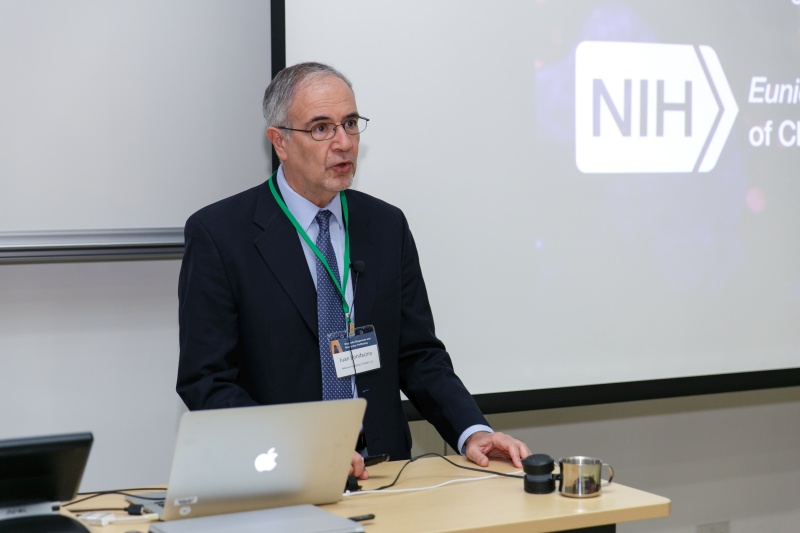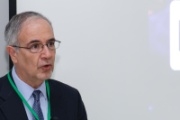Mechanisms and Functions of Lysosome Positioning
Abstract
Lysosomes are membrane-bound organelles whose main function is the degradation of biomacromolecules delivered from the endocytic and biosynthetic pathways. In recent years, however, lysosomes were found to participate in many other cellular processes, including autophagy, lipid homeostasis, cell migration, plasma membrane repair, detoxification, apoptosis, metabolic signaling and gene regulation. In the speaker’s presentation, he will describe recent work from his laboratory on a novel aspect of lysosome biology: lysosome positioning and motility. Lysosomes move back and forth between the center and the periphery of the cells. Outward movement is driven by kinesins, whereas inward movement is driven by dynein. The mechanisms by which lysosomes are coupled to these microtubule motors, however, are incompletely understood. The speaker and his group obtained unexpected insights into the coupling of lysosomes to kinesins in the course of their studies on the BLOC-1 complex that is defective in some types of the hypopigmentation and bleeding disorder Hermansky-Pudlak syndrome (HPS). Affinity purification and mass spectrometry analyses using the BLOS2 subunit of BLOC-1 as bait led them to discover a related eight-subunit complex named BORC (for BLOC-one-related complex). They found that BORC associates with the lysosomal membrane, where it functions to recruit the small GTPase Arl8. This initiates a chain of interactions that promotes kinesin-dependent movement of lysosomes toward the plus ends of microtubules in the cell periphery. Further studies showed that BORC-dependent dispersal of lysosomes is required for autophagy, cholesterol transport, cell adhesion and migration, and tumor growth. These experiments thus uncovered a molecular machinery involved in moving lysosomes to the cell periphery, and highlighted the importance of this machinery in the regulation many critical cellular processes.
About the speaker
Dr. Juan Bonifacino received his doctoral degree in Biochemistry from the University of Buenos Aires in Argentina in 1981. He then moved to the US National Institutes of Health (NIH), where he pursued postdoctoral studies. He rose through the ranks and is currently the Head of the Cell Biology and Metabolism Program (CBMP) of the Eunice Kennedy Shriver National Institute of Child Health and Human Development (NICHD) at the NIH, a position that he has held since December 1997. In 2008, he was appointed NIH Distinguished Investigator.
Dr. Bonifacino and his group at the NIH has been conducting research on signals and adaptor proteins that mediate sorting of proteins to endosomes, lysosomes, lysosome-related organelles such as melanosomes, and different domains of the plasma membrane in polarized cells such as neurons since 1990s. His group discovered new sorting signals and adaptor proteins, and applied this knowledge to the elucidation of the causes of various human diseases including the Hermansky-Pudlak syndrome type 2 (HPS-2) and HIV-1 pathogenesis. In addition, his group identified novel components of the molecular machinery involved in retrograde transport from endosomes to the trans-Golgi network (TGN), and in recycling from endosomes to the plasma membrane. In addition to continuing these studies, he is currently investigating the molecular mechanisms that control the movement of endosomes and lysosomes in non-neuronal and neuronal cells, and the connection of these mechanisms to neurodevelopmental and neurodegenerative disorders.
Dr. Bonifacino served in various editorial capacities at the journals including Developmental Cell, Molecular Cell, Journal of Cell Biology, Molecular Biology of the Cell, Journal of Biological Chemistry and Traffic. He is also the co-editor of the books, "Current Protocols in Cell Biology" and "Short Protocols in Cell Biology". He was a member of the Council of the American Society for Cell Biology and chaired various scientific conferences. He is also an Honorary Professor of Biological Chemistry at the University of Buenos Aires and a Sackler Lecturer at Tel Aviv University in Israel.











